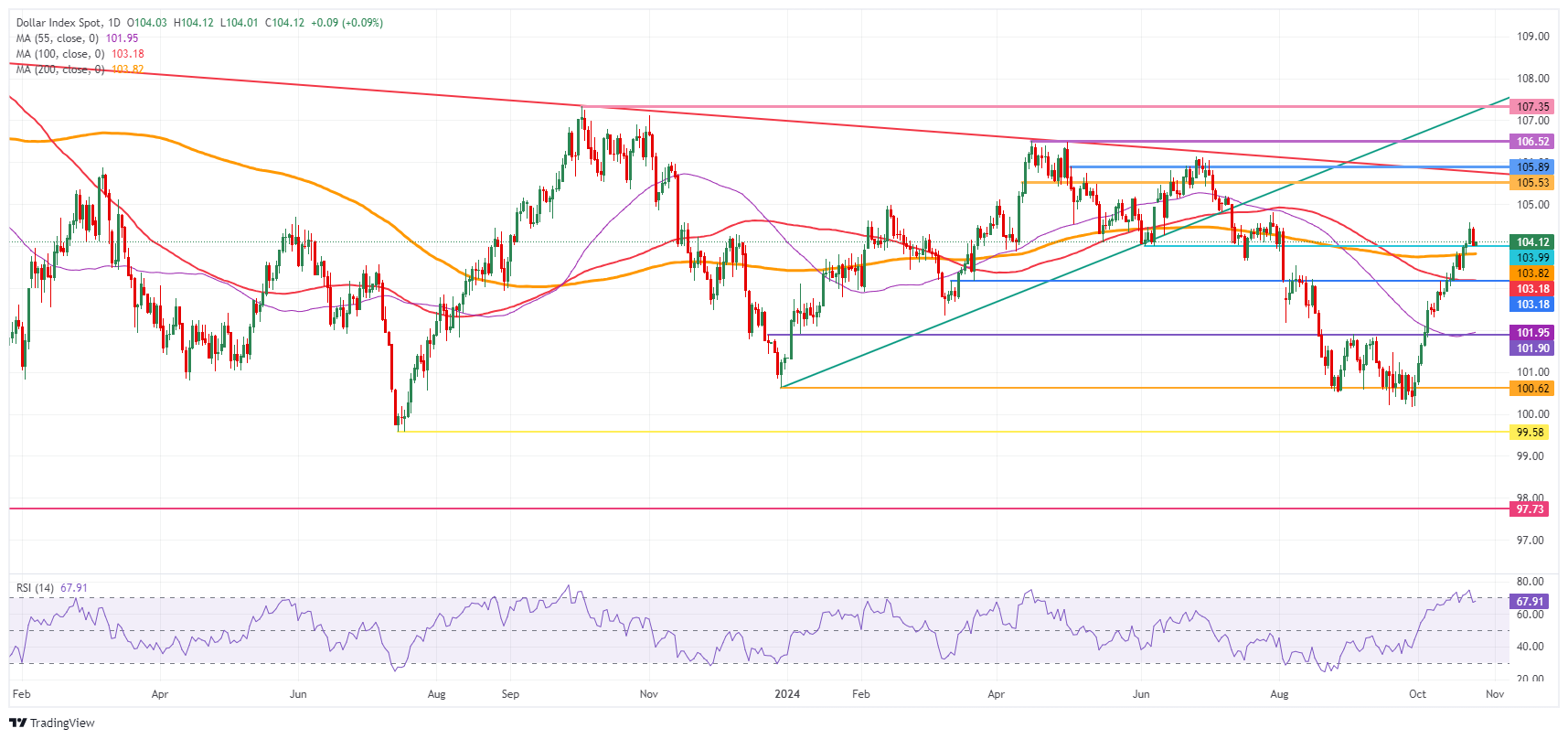US Dollar consolidates ahead of Durable Goods data
- The US Dollar consolidates following a pause in this week’s rally.
- Traders gear up for the release of Durable Goods orders data amidst US presidential election uncertainty.
- The US Dollar index hovers around 104.00, looking for support.
The US Dollar (USD) consolidates on Friday after a small retreat a day earlier, but looks set to post a fourth consecutive week of gains ahead of the release of the US Durable Goods data. In what otherwise was a steep rally this week, Thursday was a bit of a profit-taking day for King Dollar. Uncertainty surrounding the US presidential election re-emerges after taking a step back on Thursday, with polls highlighting a very tight presidential race.
The US economic calendar is facing two main events this Friday. The first will be the US Durable Goods Orders release for September. The second, and to close off the week,, the University of Michigan will release its final reading for October’s Consumer Sentiment data.
Daily digest market movers: Final straw for this week
- This Friday’s data calendar kicks off at 12:30 GMT with the Durable Goods release for September:
- Durable Goods Orders are expected to contract by 1% after remaining broadlu unchanged a month earlier.
- Durable Goods without Transportation should contract by 0.1% against the increase of 0.5% previously.
- Any revisions from the previous month might be more market-moving than the fresh number.
- Closing off this Friday at 14:00 GMT, The University of Michigan will release its final reading for October. Consumer Sentiment is expected to tick up marginally to 69.0 from the preliminary reading of 68.9. The 5-year inflation expectations are expected to remain unchanged at 3%.
- At 15:00 GMT, Federal Reserve Bank of Boston President Susan Collins participates in a conversation about the Fed’s efforts to create an economy that works for everyone at the Mass Black Expo in Boston.
- Equities are opening a touch softer this Friday, with European indices under pressure from disappointing earnings. US Futures are still looking for direction.
- The CME FedWatch Tool is backing a 25 basis point (bps) rate cut with a 97% probability against a 3% chance of no rate cut for the upcoming Fed meeting on November 7.
- The US 10-year benchmark rate trades at 4.18%, down from the high of 4.24% seen Wednesday.
US Dollar Index Technical Analysis: Looking for support
The rally in the US Dollar Index (DXY) is facing a crucial moment to confirm if it has more room to go. Support at 104.00 is being tested, and the close at the end of the US trading session will be vital. A close above 104.00 could see the DXY rally further towards 105.00 with US presidential election uncertainties picking up steam next week.
The DXY has broken above 104.00 and it is in an empty area that could quickly see 105.00 emerge as the first cap on the upside. Once above that level, watch out for the pivotal 105.53 (April 11 high) and 105.89 (May 2 high). Ultimately, 106.52 (double top from April) or even 107.35 (October 3, 2023, high) could show sharp resistance and selling pressure due to profit taking.
On the downside, the 200-day SMA at 103.81 emerges as a very strong support. Look out for false breaks, and consider waiting for a daily close below that level when reassessing if there will be more downside for the DXY. The next big support is double, with the 100-day SMA at 103.19 and the pivotal 103.18 level (March 12 high). If that level breaks, a big gap lower would open toward the 101.90 support zone, with the 55-day SMA at 101.93.

US Dollar Index: Daily Chart
US Dollar FAQs
The US Dollar (USD) is the official currency of the United States of America, and the ‘de facto’ currency of a significant number of other countries where it is found in circulation alongside local notes. It is the most heavily traded currency in the world, accounting for over 88% of all global foreign exchange turnover, or an average of $6.6 trillion in transactions per day, according to data from 2022. Following the second world war, the USD took over from the British Pound as the world’s reserve currency. For most of its history, the US Dollar was backed by Gold, until the Bretton Woods Agreement in 1971 when the Gold Standard went away.
The most important single factor impacting on the value of the US Dollar is monetary policy, which is shaped by the Federal Reserve (Fed). The Fed has two mandates: to achieve price stability (control inflation) and foster full employment. Its primary tool to achieve these two goals is by adjusting interest rates. When prices are rising too quickly and inflation is above the Fed’s 2% target, the Fed will raise rates, which helps the USD value. When inflation falls below 2% or the Unemployment Rate is too high, the Fed may lower interest rates, which weighs on the Greenback.
In extreme situations, the Federal Reserve can also print more Dollars and enact quantitative easing (QE). QE is the process by which the Fed substantially increases the flow of credit in a stuck financial system. It is a non-standard policy measure used when credit has dried up because banks will not lend to each other (out of the fear of counterparty default). It is a last resort when simply lowering interest rates is unlikely to achieve the necessary result. It was the Fed’s weapon of choice to combat the credit crunch that occurred during the Great Financial Crisis in 2008. It involves the Fed printing more Dollars and using them to buy US government bonds predominantly from financial institutions. QE usually leads to a weaker US Dollar.
Quantitative tightening (QT) is the reverse process whereby the Federal Reserve stops buying bonds from financial institutions and does not reinvest the principal from the bonds it holds maturing in new purchases. It is usually positive for the US Dollar.

